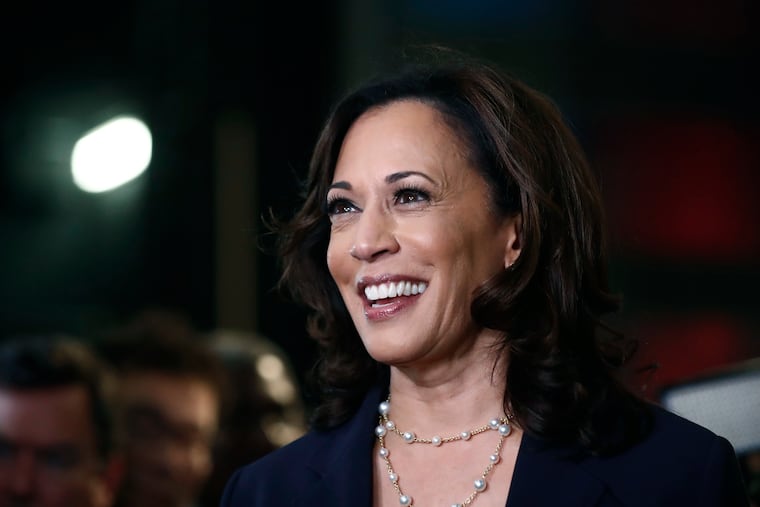On the momentum of Kamala Harris, U.S. women should continue to lead the vote | Opinion
With Senator Kamala Harris as the first woman of color on a major party’s national ticket, women are likely to be the deciding factor in November.

One hundred years ago, our foremothers could only dream of voting. Now, a woman may be only a heartbeat away from the presidency.
This November, with Sen. Kamala Harris (D., Calif.) the first woman of color on a major party’s national ticket, women are likely to be the deciding factor in what may be the most consequential presidential election in history.
On Aug. 26, our nation will celebrate the 100th anniversary of the adoption of the 19th Amendment, which states: “The right of citizens of the United States to vote shall not be denied or abridged by the United States or by any state on account of sex.” The battle for the vote lasted at least 72 years, since a resolution passed at the Women’s Rights Convention in Seneca Falls, N.Y., in 1848.
» READ MORE: What a Biden-Harris ticket means for Pennsylvania
When women activists pushed for the vote, male lawmakers’ greatest fear was that women would vote as a bloc, perhaps creating laws expanding their property rights, restricting child labor, and easing restrictions on divorce. Southern lawmakers in particular did not want to extend the vote to Black women, and managed even after ratification to keep many from voting, using the same tactics of intimidation, obfuscation, and poll taxes they had directed against Black men.
Despite their fears, the specter of a “women’s voting bloc” didn’t materialize at first. This November, we might finally see it at full power.
One hundred years ago, women were slow to take up their new role as voting citizens. When they did vote, they tended to vote as their husbands or fathers did.
But a turning point came in the 1960s. More women than men have voted in U.S. presidential elections since 1964, and have turned out at higher rates, in terms of proportion of eligible voters, in every election since 1980. By 2016, 9.9 million more women than men voted come November — 63.3% of eligible women, compared with 59.3% of eligible men, according to the Center for American Women and Politics.
A partisan “gender gap” between women and men also emerged after 1980, with women tending to choose Democratic candidates more than do men. In the 2016 election, men were 11% more likely than women to vote for Donald Trump (52% of men to 41% of women), per an exit poll by Edison Research.
» READ MORE: Kamala Harris is a Howard grad like I am. Let me school you about what that means. | Jenice Armstrong
Women’s support seems to be holding for Biden, if not climbing. In June, Biden was leading among female registered voters 59%-35% in one poll. That was up from his 19-point edge earlier this year and significantly higher than the 14-point lead Hillary Clinton had in the final 2016 polls of registered voters.
And with Harris, who is of Jamaican and Indian descent, as the vice presidential candidate, Black women’s votes could hold the real key to victory for Biden. Black women voters have already been turning out at higher rates than any other demographic, the New York Times reported. More than 90% voted for the Democratic candidate in the last three presidential elections. And Black women show the most passion for voting in general, charting the highest turnout rate among all racial, ethnic, and gender groups in 2008 and 2012.
Their participation is powering the fact that women lead the vote, across racial lines. Fifty-five percent of women who were eligible voted in the 2018 midterm, compared with 51.8% of men, according to the Pew Research Center.
» READ MORE: Revolution Museum has a remarkable story to tell about New Jersey’s inclusive voting rights — in the 1700s
This year’s turnout could be higher — and vote we must. Amid a pandemic and raging protests over police brutality, just two of many daunting issues facing the nation, our lives and our children’s lives are at stake.
Our voting power is not just hugely influential — it’s hard won. “Not only was the battle for woman suffrage fought longer in the United States, it was fought harder,” said Carrie Chapman Catt, who led the major suffrage group in 1920. “It engaged the lifelong energies of a longer list of women, called into action a larger organization in proportion to the population, and involved a great cost in money, personal sacrifice and ingenuity, than the suffrage campaign of any other land.”
Women lobbied, paraded, picketed, went to jail, and starved themselves for the vote. This fall presents another chance to honor our ancestors by using it.
Angela P. Dodson is the author of “Remember the Ladies: Celebrating Those Who Fought for Freedom at the Ballot Box” and wrote the introduction to the 100th anniversary edition of “Jailed for Freedom: A First-Person Account of the Militant Fight for Women’s Rights.”